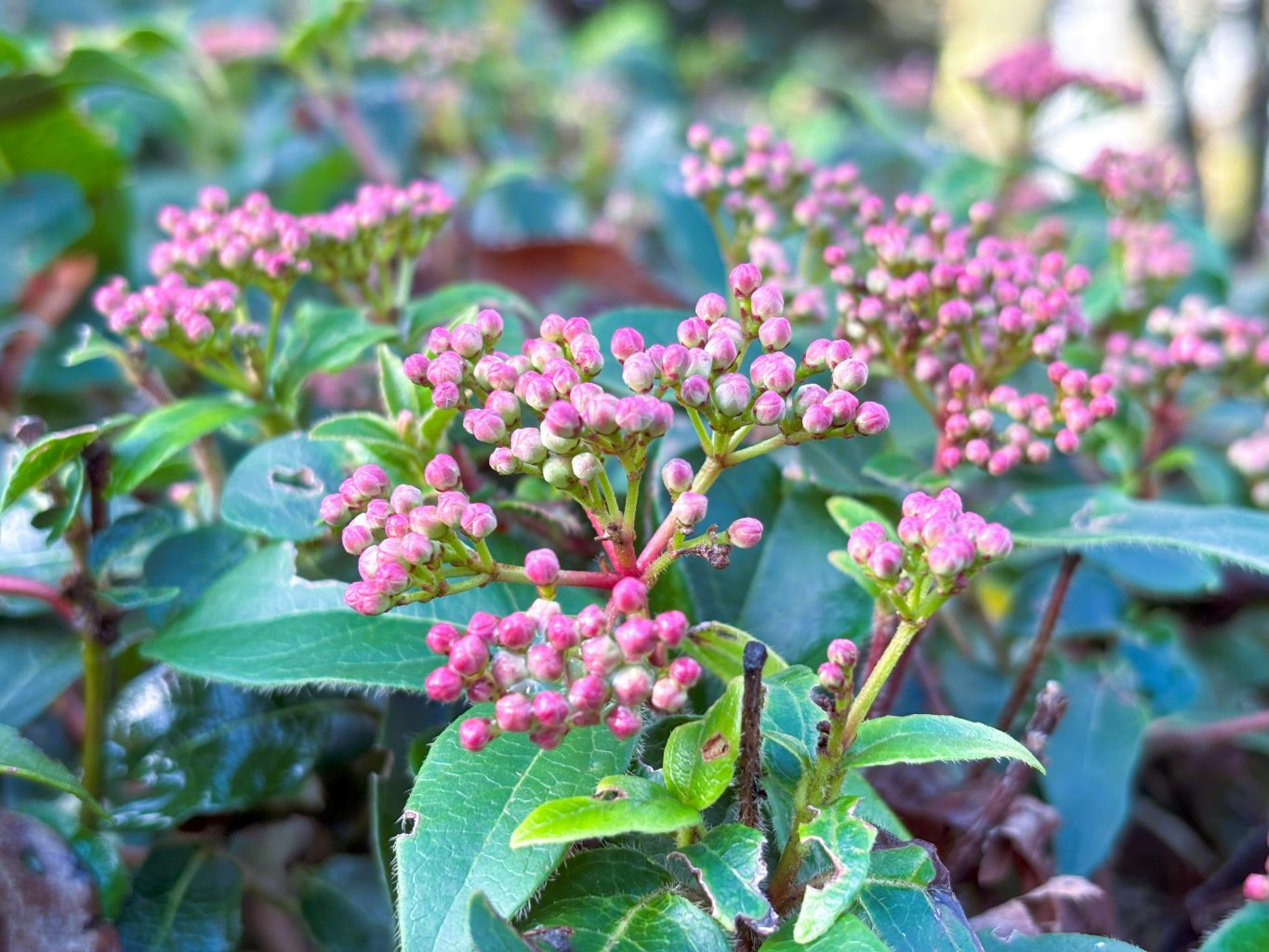Local Gardener Grow Guide:
Common Name: Laurustinus
Family: Adoxaceae
Type: Evergreen shrub
Height: 2-4 meters (6-13 feet)
Spread: 2-3 meters (6-10 feet)
Hardiness: Hardy in USDA zones 8-10, tolerating temperatures down to -12°C (10°F)
Flowering Season: Winter to early spring
Foliage: Glossy, dark green leaves
Planting Viburnum tinus
- Best Location:
Viburnum tinus thrives in full sun to partial shade. In a sunny location, it will bloom more prolifically, while in partial shade, it can tolerate dappled sunlight. It’s perfect for sheltered areas, such as near walls or fences, where it can benefit from the warmth. - Soil Requirements:
It prefers well-drained, slightly acidic to neutral soil but can tolerate a wide range of soil types, including clay and loam. For best results, amend heavy soils with organic matter to improve drainage. - Planting Depth:
Dig a hole about twice the size of the root ball. Plant the shrub at the same depth it was in its container, ensuring the root crown is level with the soil surface.
Flowering Time:
Viburnum tinus typically flowers from November to April in the UK, with peak bloom occurring in late winter to early spring (January to March). The timing can vary slightly depending on the local climate, but it generally starts flowering in late autumn and can continue into early spring.

Care and Maintenance
- Watering:
Keep the soil moist during the first year to establish roots, especially in dry spells. Once established, Viburnum tinus is drought-tolerant and will need less frequent watering. Avoid waterlogging. - Fertilizing:
Apply a balanced, slow-release fertilizer in early spring to encourage healthy growth and blooms. Organic compost or well-rotted manure also works well as a natural feed. - Pruning:
Prune after flowering to maintain a tidy shape and remove any dead or damaged wood. You can cut back some of the older stems to promote new growth and enhance flowering the following season. Light shaping can be done to control its size and encourage bushier growth. - Mulching:
Mulch around the base with organic matter to retain moisture and suppress weeds, especially during the dry months.
Pests and Diseases
- Common Issues: Viburnum tinus is generally resistant to pests and diseases but can occasionally suffer from aphid infestations or powdery mildew in humid conditions.
- Management: Remove aphids with a strong water jet or treat with insecticidal soap. Powdery mildew can be prevented with good air circulation and occasional fungicide application.
Uses in the Garden
- Viburnum tinus is a fantastic choice for year-round interest, offering winter blooms and evergreen foliage. It works well as a hedge, border plant, or in woodland gardens. Its dense growth habit also makes it an excellent choice for privacy screening.
- The white or pinkish flowers contrast beautifully against the dark, glossy leaves, and the plant is often appreciated for its fragrance, which attracts pollinators like bees.
How to Propagate Viburnum tinus
Viburnum tinus can be propagated through semi-ripe cuttings, layering, or seed sowing, but semi-ripe cuttings are the most reliable method. Here’s how to propagate it:
1. Propagation by Semi-Ripe Cuttings (Best Method)
- When to Take Cuttings:
Late summer to early autumn (August to September) is the ideal time to take semi-ripe cuttings. - Steps:
- Select a Stem: Choose a healthy, non-flowering stem that is semi-ripe—partially hardened but still flexible at the tip.
- Take a Cutting: Cut a section about 10-15 cm (4-6 inches) long, just below a leaf node.
- Prepare the Cutting: Remove the lower leaves, leaving 2-3 leaves at the top. If the remaining leaves are large, trim them in half to reduce water loss.
- Dip in Rooting Hormone (optional): Dip the cut end into rooting hormone to encourage root development.
- Plant in Growing Medium: Insert the cutting into a pot filled with a mix of moist, well-draining compost and sand or perlite (about 50:50 ratio). Firm the soil around the base.
- Provide Humidity: Cover the pot with a clear plastic bag or place it in a propagator to maintain humidity. Ensure the bag doesn’t touch the leaves.
- Position: Place the pot in a warm, bright spot out of direct sunlight.
- Watering: Keep the growing medium moist but not waterlogged.
- Rooting Time: Roots should develop in 6-10 weeks. Check by gently tugging on the cutting.
- Aftercare: Once rooted, transplant into individual pots with fresh compost. Harden them off in a sheltered area before planting out in the garden.
2. Propagation by Layering
- When to Layer:
Spring or early autumn. - Steps:
- Choose a low, flexible branch and bend it down to the ground.
- Wound the underside of the stem slightly by making a shallow cut or scraping the bark.
- Secure the wounded section in contact with the soil using a garden staple or peg.
- Cover the stem with soil, leaving the tip exposed, and water well.
- After 6-12 months, check for root development. Once rooted, sever the new plant from the parent and transplant it.
3. Propagation by Seed
- When to Sow Seeds:
Collect seeds from the berries in autumn, and sow immediately. - Steps:
- Collect ripe berries and remove the seeds by soaking them in water to soften the pulp. Clean the seeds thoroughly.
- Sow seeds in pots filled with a gritty seed compost.
- Cover lightly with compost and water gently.
- Place pots in a cold frame for cold stratification over winter (3-4 months of chilling helps germination).
- Germination may occur the following spring but can be slow and irregular.
- Note: Seed propagation can take several years to produce a mature plant, so it’s less common.
Tips for Successful Propagation
- Maintain consistent humidity for cuttings.
- Avoid overwatering to prevent rot.
- Provide frost protection for young plants during the first winter.
By using semi-ripe cuttings, you’ll have the fastest and most reliable results, making it the go-to method for propagating Viburnum tinus.
Summary
Viburnum tinus is a versatile, hardy evergreen shrub perfect for a variety of garden settings. With its winter blooms, glossy foliage, and low maintenance needs, it’s a great addition for year-round beauty. Simply ensure it has well-drained soil, a sunny or partially shaded spot, and occasional care, and it will thrive with minimal effort.




